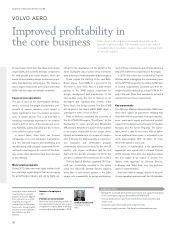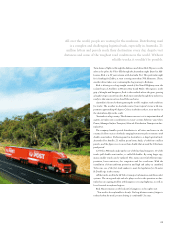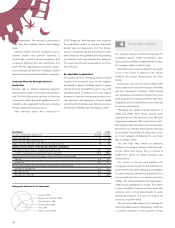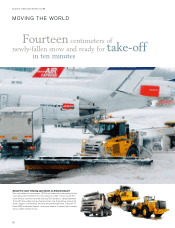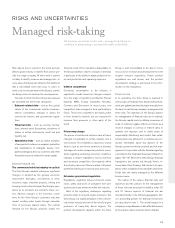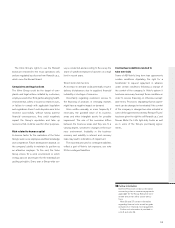Volvo 2010 Annual Report Download - page 52
Download and view the complete annual report
Please find page 52 of the 2010 Volvo annual report below. You can navigate through the pages in the report by either clicking on the pages listed below, or by using the keyword search tool below to find specific information within the annual report.
BOARD OF DIRECTORS’ REPORT 2010
in the organization. The concept is connected to
Volvo Way, the company culture, and strategic
goals.
Internal mobility between companies, across
national borders and between functions is
another way in which to secure competency and
succession planning. This also contributes to a
more efficient organization by increased experi-
ence exchange and diversity. A strategic initiative
aimed at increasing internal mobility is in progress.
Leverage diversity through inclusive
leadership
Diversity and an inclusive leadership approach
have a positive impact on innovation and product-
ivity. The Volvo Group works actively on fostering
a corporate culture aimed at capitalizing on the
strength in the organization’s diversity, including
through leadership training courses.
New numerical values were introduced in
2010: Balanced Team Indicator that measures
the quantitative aspect of diversity (nationality,
gender, age and experience from the Group’s
various companies), and the Inclusiveness Index,
which measures the qualitative diversity, meaning
how diversity work is perceived by the employees.
The results are followed up annually in the Presi-
dent’s Review.
An adaptable organization
The sudden decline in the global market in 2009
resulted in an increased focus on the organiza-
tion’s ability to adapt. A strategic goal is to secure
optimal structure and staffing levels to cope with
changing market conditions, but to also support
the launch of new technology and be able to exe-
cute decisions and implement changes rapidly
and efficiently. A Group-wide follow-up process
pertaining to flexibility was introduced in 2010.
Key figures 2009 2010
Number of employees at year-end 90,208 90,409
Share of women, % 17 16
Share of women, Board Members, % 11 12
Share of women, Presidents and other senior executives, % 19 15
Absence due to illness in the Group's Swedish companies
Total absence due to illness of regular working hours, % 3.6 3.3
of which continuous sick leave for 60 days or more, % 35.8 38.0
Absence due to illness (as percentage of regular working hours) by gender
Men, % 3.5 3.2
Women, % 3.9 3.6
Absence due to illness (as percentage of regular working hours) by age
29 years or younger, % 2.7 2.3
30–49 years, % 3.6 3.1
50 years and older, % 3.7 3.8
Company culture
4
The company culture is a critical prerequisite for
sustainable growth. Unlike technologies, strat-
egies, business models or organizational structure,
the company culture is hard to copy.
Volvo Way shows what we stand for and aspire
to be in the future. It expresses the culture,
behaviors and values shared across the Volvo
Group.
It expresses the cohesive culture, behavior and
values shared across the Volvo Group. Volvo Way
was first introduced in October 1999. Several
new businesses with different brands have since
been acquired. The industrial systems have been
integrated, and concerted efforts were underway
to enhance performance.
“Managing the global financial downturn in
2008 and 2009, Volvo Group learned some
important lessons. We need to be lean. We need
empowered employees. We need to be account-
able, aligned, agile and able to execute decisions.
We need to turn outward, add customer value and
drive change,” wrote CEO Leif Johansson in a let-
ter to all managers introducing the new Volvo
Way in October 2009.
The new Volvo Way reflects an ambitious
endeavor of creating a cohesive culture through-
out the whole Volvo Group. This is a culture of
enablement, based on global principles and
shared values:
Our culture is how we work together with
energy, passion and respect for the individual. It is
about involvement, open dialogue and feedback.
It is about diversity, teamwork and leadership. It is
how we build trust, focus on customers and drive
change. Our culture embodies individual respon-
sibility and accountability for results. This means
a clear orientation towards common goals and
solutions, and a strong determination to grow,
develop and improve. It is how we conduct our
business around the world.
The new Volvo Way supports the strategy for
delivering added value to demanding customers
in selected segments. In this customer centric
Geographic distribution of employees
Sweden 26%
Europe, excl. Sweden 32%
North America 14%
South America 5%
Asia 21%
Other countries 2%
48


